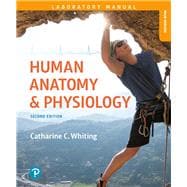Fully engage students in their A&P Lab experience
Human Anatomy & Physiology Laboratory Manual: Making Connections distinguishes itself from other A&P lab manuals by focusing on and addressing the most common teaching challenges in the lab—getting students to engage in the lab, to prepare for the lab, and to apply concepts in the lab. Catharine Whiting’s active learning approach incorporates a rich variety of hands-on activities and guided questions to get students engaged and asking questions. The 2nd Edition provides new features, such as “What You Need to Know Before You Start this Unit” at the beginning of each Unit and new Pre-Lab Video Coaching Activities to help students learn what they need to review before lab.
Developed as the companion to Erin Amerman’s Human Anatomy & Physiology, 2nd Edition, Whiting’s lab manual reflects the same superb art program and terminology found in the Amerman textbook.
Human Anatomy & Physiology Laboratory Manual: Making Connections, 2nd Edition is available in three versions for your students: Main, Cat and Fetal Pig. The Cat and Fetal Pig versions are identical to the Main version except that they include seven additional cat dissection and nine additional fetal pig dissection exercises, respectively, at the back of the lab manual.
Also available with Mastering A&P
Mastering™ is the teaching and learning platform that empowers you to reach every student. By combining trusted author content with digital tools developed to engage students and emulate the office-hour experience, Mastering personalizes learning and improves results for each student. Mastering A&P assignments support interactive features in the lab manual and include new Pre-Lab Video coaching activities, new Cat Dissection Video and Fetal Pig Dissection Video coaching activities, new fully mobile PAL 3.1 plus PAL 3.1 Customizable Flashcards, Learning Catalytics™, A&P Flix 3D muscle animations, a variety of Art Labeling Questions, Clinical Application Questions, and more.
Note: You are purchasing a standalone product; Mastering A&P does not come packaged with this content. Students, if interested in purchasing this title with Mastering A&P, ask your instructor for the correct package ISBN and Course ID. Instructors, contact your Pearson representative for more information.
If you would like to purchase boththe physical text and Mastering A&P, search for:
0134685253 / 9780134685250 Human Anatomy & Physiology Laboratory Manual: Making Connections, Main Version Plus MasteringA&P with Pearson eText -- Access Card Package , 2/e
Package consists of:
- 0134746430 / 9780134746432 Human Anatomy & Physiology Laboratory Manual: Making Connections, Main Version, 2/e
- 013474697X / 9780134746975 MasteringA&P with Pearson eText -- ValuePack Access Card -- for Human Anatomy & Physiology Lab Manual: Making Connections, 2/e










